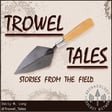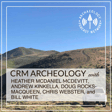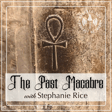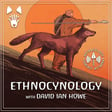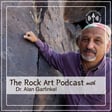Become a Creator today!Start creating today - Share your story with the world!
Start for free
00:00:00
00:00:01

Can You Dig It? - Episode 3
On today's episode, we're going to get into the nitty gritty of excavation. Learn about what kind of field schools archaeologists attended to learn how to use a trowel. Hear about the unique artifacts they uncovered. And, decide for yourself if excavating is a cool as it seems (i.e. it is!).
Transcript
Introduction to the Archaeology Podcast Network
00:00:00
Speaker
You are listening to the Archaeology Podcast Network. Welcome to Episode 3 of the Trial Tales Podcast.
Why is Excavation Exciting for Archaeologists?
00:00:13
Speaker
Today we're getting into the nitty gritty of excavation. People love hearing about the variety of digs we archaeologists get to go on. But the thing to keep in mind is that in the grand scheme of things, we don't get to do a ton of excavating. In the academic world, there are summer field schools. In the cultural resource management world, CRM, excavation is usually considered a last resort, since it is an extremely expensive thing to do.
00:00:41
Speaker
I usually don't get to do many excavation projects. I mostly survey. But when I do get to excavate, it is so much fun.
How is Excavation Approached Differently in Academia and CRM?
00:00:50
Speaker
So what is archaeological excavation? I asked a couple of my colleagues that question. In layman's terms, how would you describe it other than just digging? That's pretty layman. Digging in squares. A little less layman.
00:01:11
Speaker
Organized digging? The methodical removal of soils and the cataloging of their contents. Why? Because you get paid. Science, dude. Science.
00:01:38
Speaker
Excavation is kind of really where the hardcore science of archaeology comes into play.
The Destructive Nature of Excavation
00:01:42
Speaker
You're doing a lot of things from not just digging, but it's the samples that you're taking. It's the way that you're excavating. It's the data you're recording along the way. It's the last
00:01:54
Speaker
It's also from a CRM standpoint, the last time somebody's ever going to see any of that. I mean, any excavation is inherently destructive and nobody's ever going to see that stuff again in its natural setting, except for you. But for CRM, it's that much more poignant because even if you were to leave something in place, it's still probably going to be destroyed by some sort of development because that's why you're there. So yeah, excavation is sort of the last chance for
00:02:21
Speaker
the archaeological setting or the cultural setting to really express itself. What do you think is the difference between academic excavation and CRM excavation?
00:02:32
Speaker
So I would say the major difference between academic and serum excavation is academic excavation tends to be because of the nature of the excavation. It's being done by somebody who has either worked on that project for 20 years or a grad student that's never worked on any project ever. So a lot of times I feel like academic excavations are designed from the ground up because they've never done this or they're not working within an existing framework. So it's kind of like the hit and miss sort of wild west and they're answering very specific
00:03:01
Speaker
research questions for their thesis, dissertation, or ongoing project. Whereas CRM excavation, while we do have research questions that we're trying to answer based on that, we're using existing methodology that's been tried and tested either with your company or with the whole region or wherever you're working.
00:03:17
Speaker
whatever agency you're working for. And that's more methodical and scientific, I feel like, because we're practiced at it and it's what we do. It's not the kind of thing we're just going to do for three weeks over the summer and then teach classes for the rest of our lives.
00:03:33
Speaker
I went to a rigorous academic field school and have since been part of several large-scale CRM excavations.
Learning Excavation Techniques at Field Schools
00:03:40
Speaker
Although the pace and research objectives may differ, I do think the overarching goal is the same, to recover as much information as possible in order to reconstruct the when, how, and why people lived in that particular location.
00:03:57
Speaker
Most archaeologists have to go to a field school at some point early on in their studies or career in order to learn how to properly excavate. A field school can help a student narrow down where and what culture they would like to focus on. There are academic field schools and more CRM-oriented field schools. There are field schools in Egypt and some that are not far from your own backyard. I asked some of my colleagues about their field school experience.
00:04:28
Speaker
My first field school or my field school experience was really late in undergrad. It was the winter of my senior year and so like over Christmas and New Year's which is sort of an odd time to be doing a field school except I was doing a field school in the Caribbean on the island of Barbuda which was
00:04:53
Speaker
a crazy experience to have your first field experience because it was all these college students down on this really small population island doing salvage excavation on a beach, right? There was this saladoid period site, so a really early colonial
00:05:17
Speaker
sort of colonization of this island, which Barbuda is an interesting island. So you've got the main sort of chain of islands and a lot of them are volcanic, but Barbuda is this limestone shelf way out in the Atlantic. And it's so low in elevation above sea level that you can't see it from far away. So it's one of these cool places that past people found
00:05:46
Speaker
even though you couldn't see it. Not as extreme as what happened in the South Pacific by any means, but still pretty impressive. Anyway, so we were excavating this site that was eroding out of a dune on this beach. And I didn't realize till later that even though it was an absolutely fantastic learning experience, it really didn't prepare me for real excavation.
Hands-On Experience in CRM Excavation
00:06:14
Speaker
In the amount of work that it is, I was excavated to get a bathing suit most of the time. I'm serious. I'm serious. So I came out here as an intern. My field experience since that point was doing survey work and rerecording of large sites down here in the southwest.
00:06:38
Speaker
But as I was moving through graduate school, it became very obvious that I was going to undermine any credibility that I might have, not that I have any, but any credibility that I might have if I don't get some more excavation experience under my belt.
00:06:55
Speaker
a Crow Canyon field intern. I applied for the field internship and got a position as an intern, and we were working on a Basketmakers III site down here in southwestern Colorado, and I realized that not all archaeology was as easy as digging through sand on a beach.
00:07:17
Speaker
And instead we were digging, you know, these basket maker three pit houses that were, you know, down in Caliche. It was extremely difficult. It was also extremely rewarding and fun. And one of the things that made it so rewarding was the experience of instead of doing sort of quick archaeology, when we were down in Barbuda,
00:07:42
Speaker
We had three weeks and we had to get this site done. And I remember a couple of the graduate student teaching assistants who were part of that trip who at one point, us undergraduates were just so slow and so bad at what we were doing that they just sort of put us on this other site and then they really had to finish out the units at one of the principal sites that we were working in.
00:08:09
Speaker
As an intern at Crow Canyon, we were working with participants and actually teaching schoolchildren and adult participants how to excavate and how to understand the archaeological record through excavation and interpret the past through excavation. So it was a lot slower, but I felt like it was enhanced by that
00:08:38
Speaker
that give and take with public participants. They would ask questions that, as an archaeologist, I wasn't really thinking about. Like, how would this potsherd appear in the fill
00:08:55
Speaker
of a basket maker pit house. Why wasn't it on the floor? Why would it be in the fill? Then I'd have to talk them through how these pit houses might have been used as middens by later people and so on and so forth. Just the repetition
00:09:14
Speaker
of answering those questions that are so fundamental that we sort of forget about them often, but the repetition of answering those week in and week out really made them sink in and made me have a sort of better respect for some of those site formation processes and for the sort of beautiful
00:09:38
Speaker
I don't know how to explain it, but the beauty of excavation as a process and as a way of knowing and interpreting the past.
Uncovering Artifacts in Cyprus
00:09:54
Speaker
It's crazy to think I went to field school almost 10 years ago. It was my first big excavation and I really had absolutely no idea what to expect. It was this huge temple complex in Cyprus. There was every kind of occupation you could possibly imagine. Greek, Roman, Egyptian, medieval, and so on. It seemed like everybody wanted to go to this one area of Cyprus.
00:10:19
Speaker
So we were finding terracotta Roman lamps to Ptolemaic style statues. It was absolutely amazing.
00:10:27
Speaker
And with such a rich background, it shouldn't be that surprising that the site had been badly eluded for a really long time, which meant we had to get through tons of looters pits where everything is just this big jumble of stuff in order to get to the undisturbed cultural level with all the really amazing artifacts and all these different aspects of the temple, the altars, the pillars, the flooring, just all that amazing stuff where you know what was happening.
00:10:56
Speaker
So we're digging away with our tiny trowels just trying to get past these looters pits. It was day in day out. It's the same thing. We're all hoping to just get past these stupid pits. And it was like 110 degrees. Full sun being the young dumb college student that I was. I was in a tank top and shorts. So there I was digging away with my trowel.
00:11:18
Speaker
And all of a sudden I just hit something really hard. I brush away the dirt, and there staring up at me is the face of a statue. And it's of a Roman-style temple boy, this little, like, sweet little face. And that meant I finally hit the cultural layer, and with quite a bang it was this...
00:11:41
Speaker
beautiful statue head and it was the first major artifact I've ever found and there it was. You could still see traces of paint on the marble like a little bit of paint on the lips and on the eyes and
00:11:56
Speaker
Up until that point, I mean, everything was still in these looters pits and then this beautiful statue head. And throughout the rest of the field school, we all, everyone, found amazing artifacts. But I'll never forget uncovering that little bit of statuary.
00:12:17
Speaker
I did it in Italy and it was great. I mean, some of those people that I met on the field school, they're still good friends, like who I'd consider good friends today. It was amazing. It was a hilltop site in Umbria, pretty small. I think there wasn't that many of us out there, but we had to hike up
00:12:39
Speaker
that hill every day and at the beginning of the project we're all like oh yeah we'll be running this by the end of the day you know we're hiking up every morning six days a week with our field gear like and trials like we have boxes of trials and stuff like that we weren't really leaving that i think we left maybe the screens or something on top of the mountain but
00:12:59
Speaker
most of the stuff we were trucking up and down each day and we thought that that we would be running that thing by the end of the project and no it was last day it was still just as hard trekking up that hill as it was the first day and it's like what but I remember making like we would have
00:13:19
Speaker
Nutella and peanut butter sandwiches for lunch and stuff like that. We stayed, some of us stayed in a farmhouse and that was where we had dinner every night. And that was just the best experience. Like I remember going and we would go explore in the evenings or play a briskula.
00:13:38
Speaker
like a card game, he's brisk of an Italian card game, and it was a lot of fun. It was very small, so it wasn't like a well-known site, you know, it was just this tiny little hilltop site close to a village. We went through Roman ruin, like Roman, there was at least a Roman lair of stuff, and then I think it was ultimately an Etruscan.
00:14:02
Speaker
site and I'm not sure if it was ever as fully established exactly what it was if it was some kind of a little like habitation. It could have been I mean there was a tiny little section of flooring that we could see like cotchopesto flooring. I might be getting my words I mean this is like a decade or so ago so I might be forgetting the terminology but there was tiny little section of floor that we could see and there was a lot of pottery and
00:14:30
Speaker
stuff like that. We did find a few Etrus, like at least a couple of Roman coins and at least one Etruscan coin. And there was also a cistern that had been filled in. So there was some kind of event that happened where they decided to fill in this cistern. It was full of tile and all sorts of, and like there's some interesting things. Like I think a lot of animal bone and tiles, like terracotta tiles and stuff like that. And then there was also a burn layer. So I think the Roman
00:15:01
Speaker
remains like Roman pottery and all that was found above this burn layer and then the Etruscan stuff was below it from what I remember. But I was so new then, you know, that's like my first real experience in archaeology that I, you know, it's really hard for me to have a totally clear picture of what was going on because when you're in field school, you really don't know anything.
00:15:25
Speaker
You really have to get out there and work a lot before you really
Podcast Break and Promo
00:15:30
Speaker
start to get a good picture as to what all goes on during excavations and what you're really trying to get as far as information goes and things like that. We'll be right back after a quick break.
00:15:51
Speaker
All these things we make no apology Are the study of archaeology
00:16:02
Speaker
Did aliens build Stonehenge? Did the Easter Island statues walk? Did the Vikings colonize Midwest America? What does mainstream archaeology have to say about all of this? Listen to the Archaeological Fantasies podcast and learn about popular archaeological mysteries. Hoax or fact? Learn to tell the difference with Dr. Kenneth Fader and co-host Sarah of the Archaeophantasies blog.
00:16:23
Speaker
Check out the show on iTunes and Stitcher Radio, and at www.archaeologypodcastnetwork.com, forward slash, Arkey Fantasies, and get ready to think critically. Let's get back to the show.
00:16:46
Speaker
Welcome back.
Diverse Excavations Stories
00:16:48
Speaker
After field school, you're technically ready to set off on any kind of excavation. Here are some stories showing the wide variety of excavations an archaeologist can end up on. Excavating on a post-classic site in Belize, post-classic Maya, I was excavating a block of seated flex burials.
00:17:13
Speaker
The bottom of one of the burial excavation pits, thank you, the bottom of one of the burial pits was an almost perfectly intact tripod vessel and underneath the tripod vessel was a cache of catfish spines and then underneath that
00:17:36
Speaker
was the central column, I believe it's called a column Nella, of a conch shell that was carved into a pendant with a bird head on one end of it. And that was pretty cool. So we were working, doing, I guess technically it was testing on sites.
00:18:03
Speaker
and we were working on one. It was a huge lithic scatter. There was obsidian everywhere. It was like seven miles long. It was a huge site. So we're up there and we were in the remote camp, which is different than the man camp. We had a mess tent where we all had our meals. There was a shower trailer and then we all had, uh,
00:18:31
Speaker
Each group, there was an Alpine group and then there was other companies there. We each had our own little trailer to sleep in, which were uninsulated with prison bunk beds. At least they gave us the company that was running it gave us sleeping bags. And it was February and the Eastern side of Oregon.
00:18:57
Speaker
So cold. Oh, single digits. That was awesome. And then we were testing and everything was either straight up frozen or frozen mud that slowly thought out as you're trying to push it through screen. So the routine was get up in the morning, freezing cold, go to the mess tent, have whatever hot breakfast that they offered.
00:19:22
Speaker
And then we'd wait around for the bus that they have to take us to the ride away, which was an old immigration bus. So we'd get on there, ride to the ride away, get off there, wait around, and then they would pick us up in a hogland, which was a tracked military vehicle from Sweden. Even had like holes in the top where you could sit and look out. And then we would ride along the ride away in that until we got to where we were excavating at that particular time. So then we would spend,
00:19:53
Speaker
8, 9, 10 hours, snowing, raining, whatever. Out there, we had a little packed lunch that they would give us at the beginning of the day. Just doing excavating, picking out tiny pieces of flakes because they wanted everything. It was pretty cool because there was about three different types of obsidian on the site.
00:20:16
Speaker
Yeah, the regular black stuff, you had mahogany obsidian, which only really showed up as points. There were no flakes of that. And then they would have like a rainbow kind of, which was also, which was pretty rare. So you do that, and then you get back in the hogland, you ride back to camp, you have dinner, and then basically you drink all night, and then go to bed, and you're asleep. They're a cold trailer, and do it all the next day. Yeah, it was an interesting experience, that is for sure.
00:20:48
Speaker
But I guess when I start to really think back to, you know, in my whole career and some of the things I honestly, I go right back to my second project ever, which was an excavation in downtown Miami, Florida.
Historical Insights from a Miami Well Excavation
00:21:00
Speaker
And we were working in what we called the well, which was.
00:21:04
Speaker
a historic well dug by the Spanish, but it was also like a natural spring right near the Miami River and the inter-coastal waterway. The salty water and the brackish water from the river would soak in through the limestone and come up as fresh water right there, just a few hundred feet from the river.
00:21:22
Speaker
It was a natural place for people to come get water. But for Native Americans going back 10,000 years, it was also a place for them to bury their dead. And we had these round limestone solution holes that were either naturally created by water action or they were actually dug out with shells like conch shells and things like that. And we would just find
00:21:43
Speaker
piles of human remains because they would just gather them up and then dump them into these solution holes and we would find those and It was the only project I've ever worked on where our two artifact bags for every level that we dug Were labeled human and non-human because it was all bone so it was because we would find manatee bone turtle bone by turtle shell and in a number of other species as well manatee and turtle were the two big ones and then human bone and it was just a
00:22:12
Speaker
a real trial trial by fire on my osteological knowledge and it was uh... like i said my second project ever and i think because of that and the fact that it lasted like six months is why it really ranks high on my list and it sticks in my head all the time when i talk to people about archaeology the interesting thing about that was uh... you know on the other side of the miami river on the south side is where they found before we got there was the miami circle and that's been written about in a few publications and you can find that online because there's i think there's a
00:22:40
Speaker
I think it's been preserved as the Miami Circle now, so they're doing some stuff with it. But it's basically a circular formation of these limestone solution holes that were actually created for purpose. And then they put these posts in there and create these level platforms. And the thinking is, and I'm not sure if this is ethnographic information on this or if this is just like conjecture, but the thinking is that the Native Americans would take their dead
00:23:04
Speaker
place them on these open air platforms and just let nature take its course, whether animals got to them or they just desiccated naturally and you know, all the material, the squishy material, um, you know, just went away and then they'd be left with bones. And at some point later on, they would take these bones, gather them up, float across the river to where we were and then dump them into these holes using ceremony too, because the turtle show we found
00:23:28
Speaker
we think was upturned turtle shell and then you know fires and things burned in those like around a circle at the top of the top of the well. So it's a really interesting experience being on that. That's it for this episode. On the next episode
00:23:49
Speaker
But yeah, it was a huge project. It was in the 4600 bodies were exhumed in advance of a parking garage along the Jersey Turnpike for the train.
Preview: Discussing Human Remains in Archaeology
00:24:02
Speaker
I have found like a lot of times people who are archaeologists act like working with the burials and human remains and whatnot is a like some kind of like blue ribbon. No, it's like first of all it's not I don't like that they have to be disturbed to begin with.
00:24:19
Speaker
We're going to discuss excavating human remains in the field, working with remains in the lab, and the importance of treating every individual recovered with respect. Special thanks to Erin, Sarah, Jackie, Seth, Chris, Carrie, and Kyle, who contributed their time and stories to the podcast.
00:24:42
Speaker
Check us out on Facebook to learn more about the podcast and let us know what kind of stories you'd like to hear. Also, if you're an archaeologist and would like to contribute a tale or two, send a message. Until next time!
00:25:00
Speaker
This has been a presentation of the Archaeology Podcast Network. Visit us on the web for show notes and other podcasts at www.archaeologypodcastnetwork.com Contact us at chrisatarchaeologypodcastnetwork.com
